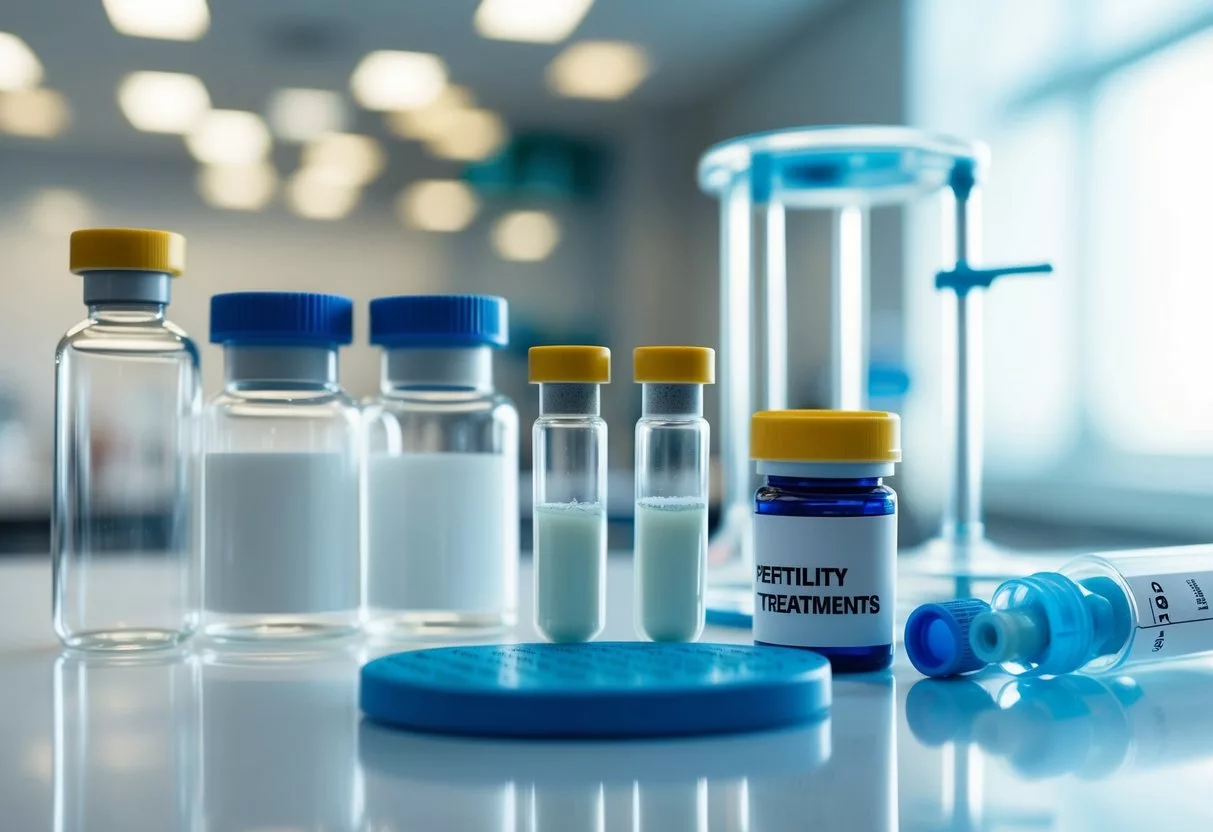Fertility treatments offer hope to couples struggling to conceive. These medical methods aim to boost the chances of pregnancy. They range from simple drugs to complex procedures.

Fertility treatments can involve medication, surgery or both to increase the chances of an egg fertilizing and implanting in the uterus. Common options include fertility drugs, intrauterine insemination (IUI), and in vitro fertilization (IVF). Each treatment targets different fertility issues.
Doctors tailor fertility treatments to each couple’s needs. Success rates vary based on factors like age and health. Many couples find success with fertility treatments, but they can be costly and emotionally taxing.
It’s key to discuss options and risks with a healthcare provider.
Understanding Fertility and Infertility

Fertility and infertility are complex topics that affect many couples. Infertility can stem from various causes and is diagnosed through a range of tests and examinations.
Causes of Infertility
Infertility can be due to issues with either partner or a combination of factors. Common causes include:
- Ovulation problems
- Blocked fallopian tubes
- Endometriosis
- Polycystic ovary syndrome (PCOS)
- Male fertility issues (low sperm count or poor sperm quality)
Some couples face unexplained infertility, where no specific cause is found. Age plays a big role in fertility, especially for women.
Lifestyle factors can also impact fertility. These include:
• Smoking • Excessive alcohol use • Being overweight or underweight • High stress levels
Diagnosing Infertility
Doctors use various methods to diagnose infertility. The process often starts with a thorough medical history and physical exam.
For women, tests may include:
- Pelvic exam
- Ovulation testing
- Hormone level checks
- Imaging tests like ultrasounds
- Hysterosalpingography to check fallopian tubes
Men typically undergo semen analysis to check sperm count and quality.
In some cases, genetic testing may be done to check for inherited disorders. Fertility evaluations can be complex and may take time.
They often involve multiple appointments and tests.
Doctors aim to find the root cause of infertility. This helps them create the best treatment plan for each couple.
Fertility Treatment Options
Many couples struggling with infertility have several options to help them conceive. These include medications, advanced reproductive technologies, and surgical procedures. Each approach offers different benefits and success rates.
Medication-Based Treatments
Fertility drugs are often the first step in treating infertility. Oral medications like clomiphene (Clomid) and letrozole (Femara) can stimulate ovulation. These pills are taken for 5 days early in the menstrual cycle.
Injectable medications called gonadotropins are another option. These contain follicle-stimulating hormone (FSH) to boost egg production. Metformin may help women with polycystic ovary syndrome ovulate.
Side effects of fertility drugs can include mood swings, hot flashes, and multiple pregnancies. A doctor will monitor response to medication closely.
Assisted Reproductive Technology (ART)
ART procedures involve manipulating eggs and sperm to help conception. In vitro fertilization (IVF) is the most common type. It involves retrieving eggs, fertilizing them in a lab, and transferring embryos to the uterus.
Intrauterine insemination (IUI) places sperm directly in the uterus during ovulation. This boosts the chances of fertilization. IUI success rates range from 5-15% per try.
Less common ART procedures include gamete intrafallopian transfer (GIFT) and zygote intrafallopian transfer (ZIFT). Some couples may use donor eggs or sperm if needed.
Surgical Interventions
Surgery can sometimes restore fertility by fixing physical problems. Laparoscopy uses small incisions to remove scar tissue, treat endometriosis, or unblock fallopian tubes.
Tubal ligation reversal can reconnect fallopian tubes in women who previously had their tubes tied. For men, varicocele repair can improve sperm production.
Surgical treatments carry risks like infection or bleeding. Recovery time varies based on the procedure. A fertility specialist can determine if surgery might help based on each couple’s situation.
In Vitro Fertilization (IVF) Process

IVF is a complex fertility treatment that helps people with infertility issues conceive. The process involves several steps, from stimulating egg production to transferring embryos into the uterus.
Stimulation and Egg Retrieval
The IVF process starts with fertility drugs to stimulate egg production. These medications help multiple eggs mature in the ovaries. Doctors monitor the patient’s response through blood tests and ultrasounds.
When the eggs are ready, the doctor performs an egg retrieval procedure. This is done under light sedation. Using a thin needle, the doctor collects eggs from the ovaries.
The number of eggs retrieved varies. It depends on factors like age and ovarian reserve. Some people may get 10-15 eggs, while others may get fewer.
Fertilization and Embryo Development
After retrieval, eggs are taken to the lab. Sperm from the partner or a donor is added to the eggs. This allows fertilization to occur.
In some cases, doctors use a technique called intracytoplasmic sperm injection (ICSI). ICSI involves injecting a single sperm directly into an egg. It’s often used when there are male factor fertility issues.
The fertilized eggs are then monitored for several days. They develop into embryos in special incubators. Embryologists check their growth and quality daily.
Embryo Transfer
The final step is embryo transfer. This usually happens 3-5 days after egg retrieval. The doctor selects the best quality embryo(s) for transfer.
Using a thin catheter, the embryo is placed into the uterus. This is a quick procedure and doesn’t require anesthesia. The patient can usually go home the same day.
Some clinics offer preimplantation genetic testing. This checks embryos for genetic issues before transfer. It can help increase the chances of a healthy pregnancy.
After transfer, patients wait about two weeks before taking a pregnancy test. This period can be stressful for many people undergoing IVF.
Alternative Fertility Treatments and Donor Options

Couples and individuals facing fertility issues have several options beyond traditional treatments. These include using surrogates, donor gametes, and considering adoption.
Surrogacy and Gestational Carriers
Gestational carriers help those who can’t carry a pregnancy themselves. A gestational carrier is not genetically related to the baby. The embryo comes from the intended parents or donors.
Surrogacy laws vary by state. Some places have strict rules, while others are more relaxed. It’s vital to work with a reputable agency and lawyer.
Costs for surrogacy can be high. They often range from $100,000 to $150,000. This includes medical care, legal fees, and compensation for the carrier.
Same-sex couples and single people may use surrogates to build their families. The process can take 1-2 years from start to finish.
Egg and Sperm Donation
Donor eggs and sperm are options for those who can’t use their own. Egg donation involves retrieving eggs from a donor and fertilizing them with sperm.
Sperm donation is simpler. It can be used for artificial insemination or IVF. Donors go through health screenings and genetic testing.
Costs vary. Egg donation is more expensive, often $20,000-$30,000. Sperm donation is cheaper, around $500-$1,000 per vial.
Success rates with donor eggs are high. About 50% of transfers result in a live birth. Sperm donation success rates depend on the woman’s age and health.
Adoption Consideration
Adoption is another way to build a family. It involves legally taking responsibility for a child not biologically related to you.
There are different types of adoption:
- Domestic (within the same country)
- International
- Foster care adoption
- Private adoption
Costs vary widely. Foster care adoption can be nearly free. Private and international adoptions often cost $20,000-$50,000.
The process can take months to years. Home studies, background checks, and waiting periods are common. Support groups and counseling can help during this time.
Adopting older children or sibling groups may be faster than infant adoption. Many agencies specialize in matching families with children who have special needs.
Success Rates and Prognosis

Fertility treatments offer hope to those struggling with infertility, but success rates vary. Key factors influence outcomes, including age and specific fertility issues.
Understanding Success Rates
IVF success rates differ by age. For women under 35, the chance of having a baby through IVF is about 50% per cycle. This rate drops to 20% for women aged 41-42.
Women over 42 have a 2.9% success rate per IVF cycle. Using donor eggs can boost success rates, especially for older patients.
Other treatments like artificial insemination have different success rates. Up to 40% of women under 40 get pregnant within six tries of AI. For IUI, success rates range from 5% to 15% per try.
Factors Influencing Success
Age is a major factor in fertility treatment success. Younger women have higher chances of getting pregnant and having a healthy baby.
Other factors that affect success include:
- Cause of infertility
- Egg quality and quantity
- Sperm quality
- Overall health
- Lifestyle factors (smoking, weight, stress)
Ovulation disorders and low egg count can lower success rates. Some clinics offer special treatments for these issues.
Multiple pregnancy is a risk with some fertility treatments. Doctors work to balance success rates with safety.
Potential Risks and Side Effects

Fertility treatments can have both physical and emotional impacts on patients. While often effective, these treatments may also lead to various complications.
Physical and Emotional Impact
Fertility drugs can cause several side effects.
Common physical effects include nausea, breast tenderness, and increased vaginal discharge. Some patients may experience soreness or bruising at injection sites.
Emotionally, the process can be stressful. Hormonal changes from medications may lead to mood swings. The uncertainty of treatment outcomes can cause anxiety and disappointment if cycles are unsuccessful.
Patients may feel isolated or overwhelmed during treatment. It’s important for individuals to seek support from partners, family, or support groups.
Treatment Complications
A serious risk of fertility treatments is ovarian hyperstimulation syndrome (OHSS).
This occurs when ovaries swell and leak fluid into the body. Severe cases can lead to blood clots, shortness of breath, or abdominal pain.
Multiple pregnancies are another potential complication. This increases the risk of premature birth and low birth weight. Fertility drugs raise the chance of twins or triplets.
Miscarriage rates may be slightly higher with IVF compared to natural conception. This risk increases with maternal age.
Some studies suggest a slightly higher risk of birth defects in IVF babies, though this link isn’t fully understood. More research is needed in this area.
Cost Considerations and Insurance Coverage

Fertility treatments can be expensive. The costs vary based on the specific procedures needed. Insurance coverage differs widely among plans and states.
Understanding Treatment Costs
In vitro fertilization (IVF) typically costs $10,000 to $15,000 per cycle. This price includes medications, monitoring, egg retrieval, and embryo transfer. Additional expenses may apply for procedures like ICSI or genetic testing.
Using donor eggs adds $20,000 to $30,000 to the total cost. A gestational carrier can increase expenses by $80,000 to $120,000.
Other assisted reproductive technologies (ART) have varying costs:
- Intrauterine insemination: $300 to $1,000 per cycle
- Fertility medications: $1,500 to $3,000 per cycle
- Egg freezing: $7,000 to $10,000, plus storage fees
Patients should ask clinics for detailed price breakdowns. Some offer package deals or shared risk programs.
Insurance and Financial Aid
Insurance coverage for fertility treatments varies greatly. Some states mandate coverage, while others do not.
As of 2024, Maine requires certain health plans to cover infertility diagnosis and treatment, including IVF.
Patients should check their policy details carefully. Many plans cover diagnostic tests but not treatments. Some may have lifetime maximums or cycle limits.
For those without coverage, options include:
- Fertility clinic financing programs
- Medical credit cards
- Grants from non-profit organizations
- Local Planned Parenthood centers for low-cost initial consultations
Some employers offer fertility benefits as part of their health plans. Patients should explore all available resources to manage treatment costs.
Lifestyle Factors and Fertility

Our daily habits and choices can have a big impact on fertility. Things like what we eat, how active we are, and where we work all play a role in our ability to get pregnant.
Diet and Nutrition
Eating well is key for both men and women trying to have a baby. A balanced diet helps keep hormones in check and supports healthy eggs and sperm.
Foods to focus on:
- Fruits and veggies
- Whole grains
- Lean proteins
- Healthy fats
It’s smart to cut back on processed foods, sugary drinks, and too much caffeine. These can mess with hormone levels and make it harder to get pregnant.
Taking a prenatal vitamin with folic acid is a good idea. This helps prevent birth defects and supports a healthy pregnancy.
Exercise and Healthy Habits
Regular exercise can boost fertility for both men and women. It helps keep weight in check and reduces stress.
Aim for:
- 30 minutes of moderate exercise most days
- A mix of cardio and strength training
But be careful not to overdo it. Too much intense exercise can mess with ovulation in women.
Other healthy habits that help:
- Getting enough sleep
- Managing stress
- Not smoking
- Limiting alcohol
These steps can improve overall health and make it easier to conceive.
Environmental and Occupational Risks
Some things in our environment can hurt fertility. It’s good to be aware of these risks.
Common hazards:
- Pesticides
- Heavy metals
- Certain chemicals
Jobs with high heat or radiation exposure can also cause fertility problems. This is more of an issue for men, as it can affect sperm production.
Endocrine disruptors are chemicals that mess with hormones. They’re found in some plastics, cosmetics, and pesticides. Avoiding these when possible may help protect fertility.
For those in high-risk jobs, taking safety steps and using protective gear is key. Some couples may want to think about fertility preservation if there’s a big risk.
Fertility Preservation

Fertility preservation helps people save their ability to have children in the future. It’s useful for those facing medical treatments that might affect fertility or who want to delay having kids.
Cryopreservation of Gametes
Egg freezing is a common method for women. Doctors remove eggs and freeze them for later use. This can be done before cancer treatment or for social reasons.
Sperm freezing is an option for men. It’s a simple process where sperm samples are collected and frozen.
Embryo freezing involves fertilizing eggs with sperm before freezing. This method is used by couples or single women using donor sperm.
Ovarian tissue freezing is newer. It’s helpful for women who need to start cancer treatment quickly.
Future Fertility Considerations
People should think about fertility early if they face health issues. Cancer treatments like chemotherapy can harm fertility.
Age affects fertility. Women’s egg quality decreases after 35. Men’s sperm quality can also decline with age.
Fertility evaluation can help people understand their options. Tests check hormone levels and egg or sperm count.
Some may need a gestational carrier if they can’t carry a pregnancy. This is an option for those without a uterus or with certain health conditions.
Costs and insurance coverage vary. It’s important to discuss these with a doctor or fertility specialist.
Cultural and Ethical Considerations
Fertility treatments raise complex cultural and ethical issues. Different societies view these technologies in varied ways. Ethical debates also surround many aspects of assisted reproduction.
Ethical Implications of ART
Assisted reproductive technology (ART) brings up many ethical questions. One key issue is the status of embryos created through in vitro fertilization (IVF). Some view embryos as having full moral status, while others see them differently.
The use of donor eggs and sperm also raises ethical concerns. Questions arise about the rights of donor-conceived children to know their genetic origins.
Genetic testing of embryos is another ethically complex area. It allows screening for certain diseases but raises worries about “designer babies.”
The American Society for Reproductive Medicine provides ethical guidelines for fertility treatments. These aim to balance patient needs with ethical considerations.
Cultural Perspectives on Infertility
Views on infertility and its treatments vary widely across cultures. In some societies, having children is seen as a key duty. This can put pressure on those struggling with fertility.
Religious beliefs often shape attitudes toward ART. Some faiths fully embrace these technologies. Others have restrictions or oppose certain methods.
Many cultures place high value on genetic connections. This can affect choices about using donor eggs or sperm. It may also influence views on adoption as an alternative.
Surrogacy is accepted in some cultures but controversial in others. Laws and attitudes differ greatly around the world.
Cultural factors can impact access to fertility treatments. In some places, only married couples can use ART. Other regions have more inclusive policies.
Frequently Asked Questions
Fertility treatments offer various options for individuals and couples struggling to conceive. These treatments range from medications to assisted reproductive technologies, each with different costs, processes, and success rates.
How do fertility treatments vary in cost and what are the financial considerations?
Fertility treatment costs can vary widely. In vitro fertilization (IVF) is often more expensive than other treatments like intrauterine insemination (IUI). Some insurance plans may cover certain fertility treatments.
Patients should consider not just the initial cost, but also potential expenses for multiple rounds of treatment. Many clinics offer financing options or payment plans to help manage costs.
What are the options for infertility treatment in females?
Female infertility treatments include fertility drugs to stimulate ovulation, surgery to repair fallopian tube damage or remove fibroids, and assisted reproductive technologies like IVF.
Intrauterine insemination is another option where sperm is placed directly into the uterus. The choice of treatment depends on the underlying cause of infertility and other individual factors.
Can you explain the IUI fertility treatment process and its success rates?
IUI involves placing specially prepared sperm directly into the uterus during ovulation. The procedure is typically quick and relatively painless.
Success rates for IUI vary based on factors like age and the reason for infertility. Generally, success rates range from 10% to 20% per cycle, with higher rates for younger patients and those with unexplained infertility.
Are there specific treatments recommended to increase the chances of getting pregnant more quickly?
Recommended treatments to boost fertility include taking folic acid supplements and maintaining a healthy weight. Tracking ovulation can help time intercourse for the best chance of conception.
For some patients, fertility drugs like Clomid may be prescribed to stimulate ovulation. Lifestyle changes such as quitting smoking and reducing alcohol intake can also improve fertility.
What are the most effective fertility drugs available for those trying to conceive?
Common fertility drugs include Clomiphene citrate (Clomid) and Gonadotropins. These medications work by stimulating ovulation in women with irregular cycles or ovulation disorders.
Injectable hormones like follicle-stimulating hormone (FSH) and luteinizing hormone (LH) may be used in more advanced treatments. The most effective drug depends on the individual’s specific fertility issues.
What is the typical process a patient undergoes when starting fertility treatments?
The fertility treatment process typically begins with a comprehensive evaluation. This includes a review of medical history and physical exams. Fertility tests for both partners are also done.
Based on the results, the doctor will recommend a treatment plan. This may start with lifestyle changes or fertility drugs. The plan can progress to more advanced treatments if needed. Regular monitoring and adjustments to the plan are common throughout the process.